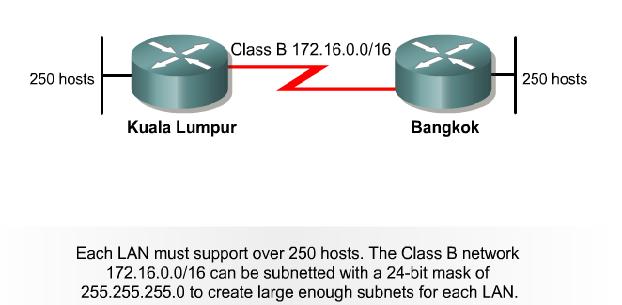Introduction to Classless Routing
From Mycomputer Notes
(→Calculating subnets with VSLM.) |
|||
| Line 39: | Line 39: | ||
</blockquote> | </blockquote> | ||
| + | |||
| + | Summarization is the number of common bits that the route | ||
| + | will adverstized for the different subnets. | ||
| + | |||
| + | |||
| + | |||
| + | =External Link= | ||
[http://xtronics.com/reference/ip-subnetmasks.htm IP Mask] | [http://xtronics.com/reference/ip-subnetmasks.htm IP Mask] | ||
Current revision as of 18:04, 26 October 2006
Network administrators must anticipate and manage the physical growth of networks. This may require them to buy or lease another floor of a building for new network equipment such as racks, patch panels, switches, and routers. Network designers must choose address schemes that allow for growth. IPv4 offered an address strategy that was scalable for a time before it resulted in an inefficient allocation of addresses. IPv4 may soon be replaced with IP version 6 IPv6 as the dominant protocol of the Internet. IPv6 has virtually unlimited address space and implementation has begun in some networks.
As the enterprise network grows an Network Administrator needs to work with its IP address more efficiently; in this section VLSM and the CIDR notation will be introduced. Classless Interdomain Routing (CIDR) -The CIDR notation is the expression in bits that identifies the network and host portion of an IP address.
In order to used VSLM an administrator must configured a router with a routing protocol that supports it. Cisco routers support VLSM with:
- OSPF
- Integrate IS-IS
- EIGRP
- Static Routing
VLSM allows an organization to use more than one subnet mask within the same network address space. VLSM implementation maximizes address efficiency, and is often referred to as subnetting a subnet.
Classful routing protocols require that a single network use the same subnet mask. As an example, a network with an address of 192.168.187.0 can use just one subnet mask, such as 255.255.255.0.
A routing protocol that allows VLSM gives the network administrator freedom to use different subnet masks for networks within a single autonomous system. Figure shows an example of how a network administrator can use a 30-bit mask for network connections, a 24-bit mask for user networks, and even a 22-bit mask for networks with up to 1000 users.
When to use VSLM
When designing a LAN an administrator needs to think how the LAN will growth. He needs to design an address
scheme that allows for growth and does not waste addresses.
A class in the example class C can be break up in several subnets. Large subnets are used for the LAN and small
subenets are created for the Point-to-Point links , WAN links or other special cases.
A 30 bit subnet mask is used to create subnets with only 2 valid host
In the example one of subnets have been subnetted again. This time we can used a /30 bit mask. Now the administrator has 8 range of addresses for the ponit to point links.
[edit] Calculating subnets with VSLM.
VLSM helps to manage IP addresses. A subnet mask should satisfy the requirements of a LAN with one subnet mask and the requirements of a point-to-point WAN with another. Lets start with an example with a Class B 172.16.0.0 and two LAN that requires at least 250 host. If the router uses a clasfull subnet the WAN link must be a subnet of the same class B Network. Without VSLM the WAN link would need the same subnet mask as the LAN segments. A 24 bits mask of 255.255.255.0 can support 250 host. This WAN link only needs two addresses, one for each router, meaning that 252 addresses will be wasted. In this case we can use VSLM and used a subnet mask of /30 bits , since only two addresses are need it.
Summarization is the number of common bits that the route
will adverstized for the different subnets.

